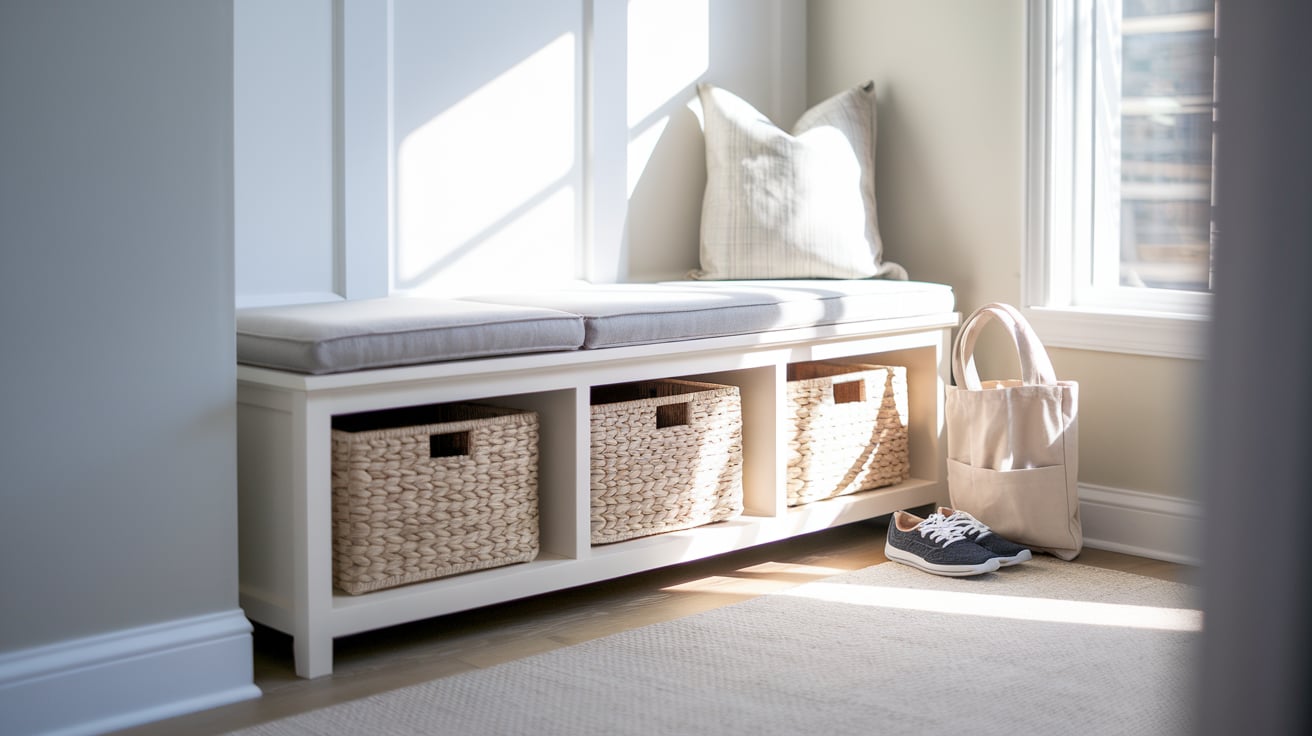Standing by your door, juggling keys, bags, and shoes? That daily scene might feel familiar to many homeowners.
A well-built entryway bench can turn your cluttered entrance into an organized space. Building one yourself costs less than store-bought options and gives you control over size and style.
You can make a bench that fits your needs with basic tools and materials from your local store. This guide shows you how to build a sturdy, good-looking bench on a weekend, even if you’re new to woodworking.
Follow our simple steps to create a bench that makes your entryway work better for you. Let’s start building something useful for your home.
Tools and Materials Required
Tools Required
| Tools Required | Purpose |
|---|---|
| Brad Nailer | For securing wood pieces |
| Drill | For pocket holes and screws |
| Pocket Hole Jig | For creating hidden joints |
| Sanding Sponge (120 grit) | For smooth finish |
| Paint Brush | For primer and paint |
| Measuring Tape | For accurate sizing |
| Saw | For cutting wood pieces |
Materials Required
| Materials Required | Quantity |
|---|---|
| Plywood Sheets | Based on bench size (for main structure) |
| 1×3 Lumber | 5x the bench length |
| Wood Glue | 1 bottle |
| 1¼ inch Brad Nails | 1 box |
| Pocket Hole Screws | 1 box |
| Wood Filler | 1 container |
| Primer | 1 can |
| Paint | 1 can |
| Optional: Cushion | 1 piece sized to bench top |
Note for Wood Selection:
- Main Structure: ¾ inch plywood
- Support Pieces: 1×3 pine lumber
- Choose paint-grade materials if painting
- Select stain-grade wood if planning to stain
Step-by-Step Guide to Building Your Entryway Bench
Step 1: Plan and Prepare
Start by measuring your entryway space. Cut the plywood sheets into the main pieces – sides, top, bottom, and dividers.
Your bench will need at least two dividers to create storage sections. Mark all your pieces clearly before moving to assembly.
Step 2: Basic Frame Assembly
Begin with the base of your bench. Join the bottom shelf to the two side pieces. Place your pre-cut base supports as guides for the dividers.
Fix the dividers from the bottom using 1¼ inch-brad nails and wood glue. This method keeps all fasteners hidden from view.
Step 3: Support Structure
Add strength to your bench by installing base supports. Use pocket holes on the back and top sections. Work with gravity by turning the bench to positions that let you drill downward.
For benches longer than 4 feet, add a center leg support. This prevents sagging and adds stability.
Step 4: Bottom Trim Installation
Start the trim work at the bottom of your bench. Measure and cut pieces as you go for the most accurate fit. Begin with the side trim pieces, then add the front trim.
When nailing into thin plywood, angle your nails slightly for better grip. This creates a solid bond between pieces.
Step 5: Top Section Construction
Move to the top section of your bench. Install the back piece using pocket holes for secure attachment. Add side pieces with a mix of wood glue and nails.
Make sure all supports are level and properly secured. This creates a stable surface for seating.
Step 6: Finishing Touches
Complete your bench with careful attention to detail. Fill all nail holes with wood filler. Sand the entire bench using a 120-grit sanding sponge.
Remove all dust thoroughly. Apply primer to all surfaces, then paint your bench. Once dry, attach the top using pocket hole screws from underneath.
Step 7: Storage Bay Organization
Add the internal support pieces in each storage bay. These supports run along the back and sides of each section. Secure them with wood glue and brad nails. This creates sturdy compartments for storage baskets or items.
Step 8: Top Trim Detail
Cut the side trim pieces for the top at a slight angle to create a softer edge. This makes the bench more comfortable for seating. For a clean look, attach these pieces to the top panel’s sides using glue and nails.
Step 9: Surface Preparation
Before finishing, check all surfaces for gaps or imperfections. Fill any seams between the trim and plywood with wood filler. Let it dry completely. Sand these areas extra carefully to ensure a smooth transition between pieces.
Step 10: Paint Preparation
Remove all dust with a brush or cloth. Consider painting the bench in two separate pieces – the base and top. This makes it easier to reach all inside corners and ensures complete coverage.
Step 11: Paint Application
Apply primer evenly to all surfaces. Once dry, sand lightly between coats if needed. Add your chosen paint color in thin, even layers. Let each coat dry completely before adding another.
Step 12: Final Assembly
Once all paint is fully dried, attach the top to the base. Use the pre-drilled pocket holes in the back top supports. Secure through the flat base supports with pocket hole screws. This keeps all fasteners hidden from view.
Video Tutorial
Check out this YouTube video for a detailed step-by-step tutorial on making an entryway bench.
Additional Tips for Success
1. Helpful Construction Tips
- Build your bench in sections for easier handling and painting
- Test fit all pieces before adding glue or nails
- Use a level frequently during assembly
- Create small blocks as spacers to maintain even gaps
- Keep a damp cloth ready to wipe away excess glue
2. Storage Solutions
- Plan your storage bays to fit standard basket sizes
- Consider making one bay taller for boots or larger items
- Leave small gaps between dividers for easier basket sliding
- Mark bay measurements on paper first to optimize space
3. Paint and Finish Tips
- Keep the base and top separate during painting
- Paint inside areas first, then move to outer surfaces
- Let each coat dry fully in a well-ventilated space
- Consider adding felt pads under the base to protect the flooring
- Apply a clear coat for high-traffic areas
4. Structural Support Tips
- Add extra support for benches over 4 feet long
- Place center support legs where they won’t interfere with storage
- Check all joints are tight before adding trim
- Double-check all pocket holes are positioned correctly
5. Safety Tips
- Wear safety gear during cutting and assembly
- Work in a well-lit area
- Pre-drill holes near edges to prevent wood splitting
- Keep tools organized and within reach
- Take breaks to maintain focus and precision
Common Mistakes to Avoid
1. Measurement Mistakes
- Wrong Space Calculations: Take measurements at least twice before cutting any materials. Remember that trim adds extra thickness to your final dimensions. Wall corners might not be perfectly square, so measure diagonally.
- Poor Material Planning: Plan your cuts on paper first to maximize material use. Laying out all pieces before cutting prevents waste and ensures efficient use of plywood sheets. Mark your cut lines clearly with a pencil.
- Incorrect Support Placement: Long benches need center support to prevent sagging. The support should be properly measured and placed in the middle section for maximum stability.
2. Assembly Errors
- Test Fitting Issues: Test fit all pieces before applying glue or nails. Parts should come together smoothly without force. Rushed assembly leads to misaligned sections.
- Glue Application Problems: Apply glue in thin, even layers. Wait for each glued section to dry fully. Wipe excess glue immediately with a damp cloth to prevent staining.
- Support Structure Failures: Include support blocks behind each divider. These blocks strengthen the overall structure and prevent wobbling over time.
3. Structural Problems
- Top Support Issues: The bench top needs proper support across its length. Place pocket holes strategically to secure the top without visible fasteners.
- Fastener Placement: Keep nails and screws away from wood edges to prevent splitting. Secure center supports firmly using both glue and mechanical fasteners.
- Leveling Problems: Check levelness throughout assembly using a reliable level tool. Small adjustments early prevent major issues later.
4. Finishing Flaws
- Surface Preparation Issues: Fill every nail hole completely with wood filler. Sand surfaces thoroughly and remove all dust before applying any finish.
- Paint Application Problems: Sand between paint coats for smooth results. Work in good lighting to spot imperfections. Apply thin, even coats of paint to prevent drips.
5. Storage Design Issues
- Space Planning Problems: Design storage bays to fit standard storage containers. Account for taller items like boots when planning bay heights.
- Organization Mistakes: Consider different storage needs when sizing compartments. Leave small gaps between dividers for airflow and easier basket removal.
- Assembly Oversights: Secure the top properly using multiple attachment points. Check all connections before considering the project complete.
Conclusion
Building an entryway bench brings function and comfort to your home’s entrance.
This simple DIY project helps solve storage needs while giving you a place to sit. With basic tools and careful steps, you can finish this project in a weekend.
Making your bench means getting the exact size and style that works for you. Plus, you’ll save money compared to buying pre-made furniture.
The divided storage sections keep items tidy, making your entryway look clean and organized.
Remember that good maintenance will keep your bench sturdy and attractive for years. Regular cleaning and checks will protect your work.
Soon, you’ll have a practical piece of furniture that makes your home more welcoming and organized.









